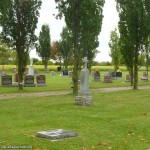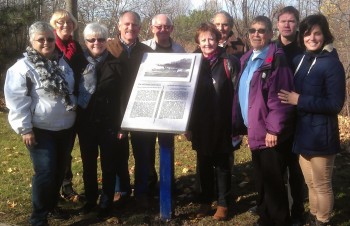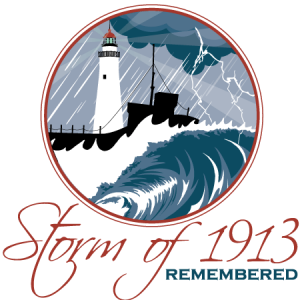Service
Wednesday November 11 at 11 AM
On the 11th hour of the 11th day of the 11th month,
Canadians are asked to pause in memory of the thousands of men and women
who sacrificed their lives in military service.
Service
Wednesday November 11 at 11 AM
On the 11th hour of the 11th day of the 11th month,
Canadians are asked to pause in memory of the thousands of men and women
who sacrificed their lives in military service.
 Dianne Tucker, St. Joseph and Area Historical Society member, photographed all the tombstones in St. Peter’s Catholic Church Cemetery last summer. The results are on-line here.
Dianne Tucker, St. Joseph and Area Historical Society member, photographed all the tombstones in St. Peter’s Catholic Church Cemetery last summer. The results are on-line here.
A lovely, solemn day. Thank you to all who could join us.
Some photos:

Last year our area commemorated the Great Storm of 1913.
For our part we presented a very successful dinner theatre “The White Hurricane”. During the evening we raffled off prints of the ships we featured in the production. Proceeds of the raffle and a generous grant from the Municipality of Bluewater allowed us to erect another historical plaque in St Joseph’s Memorial Park. The plaque faces the spot in the lake where the Wexford lies.
 Duncan McGregor was presented with the Warden’s Award by Huron County Warden Joe Steffler at the Huron Arts & Heritage Network awards night on May 2, 2014. This award recognizes outstanding achievement by an individual across all categories. The St. Joseph & Area Historical Society congratulates Duncan for this well deserved recognition.
Duncan McGregor was presented with the Warden’s Award by Huron County Warden Joe Steffler at the Huron Arts & Heritage Network awards night on May 2, 2014. This award recognizes outstanding achievement by an individual across all categories. The St. Joseph & Area Historical Society congratulates Duncan for this well deserved recognition.
Joe Wooden and Pat Rowe are congratulated for receiving a joint nomination for the Community Contribution Award.
Submitted by Joe Wooden
This is the first of a series of articles covering the Great Storm which devastated the Great Lakes area in 1913.
The St. Joseph and Area Historical Society is providing these articles and in November, the Historical Society will be offering a dinner theatre event at Hessenland to commemorate the Great Storm.
The causes of the weather conditions have been described in various ways. This report uses some recent work by James Clary of St. Clair MI, using US weather service information.
This year, 2013, is the 100th anniversary of the most devastating storm conditions every to strike the Great Lakes since records were kept and non-native settlements existed. This storm or storms, to be accurate, produced heavy snow falls and rains, thirty-five foot waves, hurricane force winds, the lowest barometric pressure readings observed in North America until 2011. These weather conditions experienced on the Great Lakes in November, 1913 took the lives of 250 sailors, perhaps more; the numbers vary in different records. Many ships were destroyed, shore facilities were damaged, and lakeshore communities were severely affected. The causes of the weather conditions have been described in various ways. This report uses some recent work by James Clary of St. Clair MI, using US weather service information.
There were two storms associated with the two frontal depressions. One of these formed over northern Wisconsin and it reached Lake Superior on November 6.
This depression produced northerly gales on Lake Superior and Lake Michigan on the night of November 6 and 7 and on Lake Huron by early November 8. This depression moved easterly and this resulted in an easing of storm conditions. As the winds diminished ships’ captains ordered their vessels onto Lake Erie, into the Detroit River and the St. Clair River and through the Mackinac straits and down the St. Mary’s River. So numbers of ships were moving on November 8 and 9.
What the ships’ captains did not know about was the formation on November 9 of a frontal depression moving along Lake Erie. What they did not know was the more than abnormal barometric pressure readings. The lowest reading recorded was at Erie. Pennsylvania where the eye of the storm was over that town; the reading was 28.61 “. It has been commented by present day students of the weather that occurred in November, 1913, that this figure may have been the lowest recorded in the United States until the hurricane which came up the eastern seaboard of the United States in 2011. The lower the barometric pressure higher and higher wind speeds result. In the northern hemisphere winds move in a counter clockwise direction around a frontal depression and you can plot wind directions in the lakes as this depression advances.
This depression moved north and created the weather conditions which devastated Lake Erie, lower Lake Michigan and Lake Huron. Wind speeds exploded. The term used for what this depression created was “weather bomb”. Winds reached 80-90 miles per hour. Waves as high as 35 feet were reported. As the depression moved wind speeds and directions changed unpredictably with wave directions changing in a confused pattern. The storm brought rain and snow.
Snow falls were heavy from Cleveland north to the shores of Lake Huron with depths on the ground reaching four feet. The air was white with wet snow, hence the term “white hurricane” as the high winds whirled the snow as it fell. The storms incredible intensity lasted for 16 hours, late into the night of November 9-10.
Weather science in 1913 was in its infancy. The paths of frontal depressions were difficult to forecast. In retrospect it seems that the first depression with its stormy gale force winds moved off to the east thus creating a situation which seemed to allow a captain to order his vessel out. What was not known was the coming of the second storm which may have come over the Appalachians to the south of the Great Lakes Basin. So the absence of forecasting science, the lack of radio communication on the ships and the approaching end of the navigation season all conspired to encourage the shipping companies and the captains to move their ships out after the original gales diminished.
The result was serious loss of life and the loss or partial destruction of about 40 vessels. Future articles will provide descriptions of these losses and stories about the crews. The next article will look at one of the ships and the rescue of the crew.
The Wreck of the “Northern Queen” during the White Hurricane of November, 1913- Port Franks
Submitted by Joe Wooden
The “Northern Queen” went down off Port Franks as a result of the worst storm in the history of navigation on the Great Lakes. The “Northern Queen” was a 2500 ton steamer, 300 feet long and 41 feet in the beam. There is no record of what its cargo was.
The story of its wreck is one of great courage and strength on the part of the crew and of great kindness and generosity of the local people in the Port Franks area.
The details of the events concerning this ship’s last days come from the Parkhill Gazette and the Port Huron paper. There are significant differences in the two reports. Anyway, the “Northern Queen” passed port Huron northbound on Sunday morning November 9 and sailed about 40 miles north in terrible weather. By the time Captain Crawford turned his ship around to go back south the storm was a “white hurricane.” One report suggests that the “Queen” nearly made it to Port Huron but turned north again and found the storm made it impossible to do anything. According to one report the ship was about 8 miles off Port Franks, unable to sail further. Captain Crawford described waves of tremendous heights pounding over the ship “stripping some of the upper works and smashing through the ports.” Water poured into the Captain’s quarters and throughout the ship putting out most of the boiler fires and leaving the ship without steam for power. At some point the ship lost its rudder and drifted. On Monday the ship “dropped into the triangle of the sea” and the crew lowered both anchors. After a time there was “a sudden lurch she shivered and crunched from stem to stem…there was a terrible crash and we knew she had lost both anchors.”
So the crew are now without any way of steering or controlling the ship as it drifted rapidly before the wind. Sometime on Monday the Northern Queen was a mile off Port Franks. The men had no food, no fires for warmth, and they clustered together on the bow soaked, cold, and miserable in the still heavy seas. On Tuesday morning they were about 1000 yards off shore. The Captain ordered the one remaining life boat over the side and 10 men went over the side into the lifeboat. Great effort was needed to keep the boat from being smashed against the hull of the ship. According to one report a cable had been attached to the lifeboat so that it could be pulled back to the ship. The cable, however, snapped. The 10 crew members got to shore with the help of local people who took them into their homes to be fed, dried, and warmed up after days of exposure to wind, snow, cold water, and lack of food.
Here the stories vary. One story has the crew attaching a cable to a large crate of goods and throwing the crate overboard. When it drifted close to shore the local men went in and pulled it to shore. The cable could now be attached to the life boat and pulled back to the ship.
Another version of the story has 2 of the crew from the group of 10 taken to shore trying to return the life boat to the ship only to be capsized in the heavy surf. In this version a second life boat was then launched from the ship to take 9 crew members to shore leaving the captain, the first mate, William McDonald, and the second mate.
One way or another last three were taken ashore and the crew of 22 from the “Northern Queen” were saved by their own courage and fortitude and by the aid given to the crew by the local people.
The ship itself may have drifted further south before it finally went to the bottom. Evidently a number of years ago divers looking for a ship northwest off Kettle Point may have been looking for the “Northern Queen”. The official location of its sinking is Kettle Point.
This is just one anecdote of many related to the great storm of November, 1913.
November has always been the critical month for Great Lakes storms
Submitted by Pat Rowe
November has always been the critical month for Great Lakes storms, but researchers and sailors agree with author Fred Landon who wrote the following:
“Sunday, Nov. 9, 1913 is the blackest day in the history of navigation on the Great Lakes.”
Within a 72 hour span, 13 ships were completely lost and between 230 and 260 people died. Lake Huron alone claimed 8 of those ships. This story recounts the tragedy of just three vessels, and if you manage to read it all, I hope you will want to buy some scuba gear, or purchase a good boat, or pay a visit to your local library or book store. Please do read on!
The first ship is the Regina, named after the capital of Sakatchewan. She was built in Scotland but was Canadian owned which meant, that although smaller than most of these ships, she must have been sufficiently seaworthy to survive an Atlantic crossing to her home port of Montreal. James Clary’s book, “The 1913 Storms” says this about the Regina:
“ You might say she was a floating general store.”
Listed regularly on her manifests were items such as paint, hardware, kitchen utensils, cloth, and food supplies. Each shipping season she visited ports all up and down the lakes. On Nov.9, she was going north from Port Huron, top heavy with sewer pipe but she completely vanished in the storm. Her final resting place between Port Sanilac and Lexington in Michigan was not discovered until 1986 when divers found much of her cargo, including bottles of still drinkable scotch and champagne. Today, this site is a part of Michigan’s underwater park system and, I am told, an excellent dive location.
Next is the Wexford, also an ocean going ship, constructed in England. She too came under Canadian ownership and although she had no trouble coping with Atlantic weather, she fell victim to Lake Huron’s waves. She was coming south from Fort William/Port Arthur (now Thunder Bay) with a load of grain and was to make port in Goderich. There are stories which tell of Goderich residents who thought they heard the ship’s whistle on the 9th but perhaps the boat was unable to find the harbour, or indeed navigate into it under the terrible conditions. Her captain was the newly appointed Frank Bruce Cameron of Collingwood. He was just 26 years old but came from a family of mariners which enabled him to become an experienced and able seaman for one so young. This voyage was both his first and last as a ship’s master because he is remembered as the youngest captain to die in the 1913 storm. The lake gave proof of this ship’s loss over the following days when wreckage and bodies of the crew began washing ashore from near Goderich south as far as Point Edward.
The Wexford was found by a fisherman, quite by accident, in August of 2000. Quickly, shipwreck hunters along with members of the Goderich Marine Heritage Committee explored and verified her location, NNE of Grand Bend which, I believe, makes it in the lake west of St. Joseph, does it not?
The James Carruthers is last boat included this article. This ship was the newest, the largest, and the most expensive of all the ships on all of the Great Lakes during the storm. Unlike the first two, she was Canadian built in Collingwood and just launched in May of 1913 and, like the other two, she was Canadian owned. She was said to be one of the best built boats on the lakes. Brand new! Unsinkable! It somehow reminds me of the Titanic.
The Carruthers was southbound from Superior with a cargo of grain en route to Midland.
Robert Hemming, author of “Ships Gone Missing” tells us that one of the crewmen on Carruthers waved to a friend on an upbound ship as the two boats passed by one another in the St. Marys River just south of the Soo. The distance was not far so he shouted across the water:
“We’re going to Midland this time, Jack. I’ll tell your father we passed you.”
But the James Carruthers never arrived in Midland. Bodies and wreckage from this ship washed ashore in an area from around Point Clark south to near Goderich. The mystery remains. Why was she so far south when she was supposed to go east around the Bruce Peninsula to Midland? And in this present year she still has not been found, so where on the bottom of Lake Huron is she?
There it is – three ships, all Canadian and all lost in the same storm. Now find your scuba gear and visit the dive site at the Regina, or take your new boat out on Lake Huron and become famous by finding the Carruthers, but, if those options seem beyond you, obtain a copy of Paul Carroll’s book, “The Wexford” or perhap Hemming’s, “Ships Gone Missing.” These books are two gems written in an informative yet entertaining way to help you to become an avid fan of Huron County history.
Thank you – all shows are sold out and the waiting list is closed

Approximately 20 community actors and musicians will bring to life the first hand experiences of St. Joseph and nearby communities (from north of Goderich to south of Grand Bend plus more in-land towns such as Zurich, Exeter and Hensall) during the storm and its aftermath. The event begins in the main building of Hessenland Country Inn. Guests arrive at the main dining room (Garden Room) where they are greeted with drinks and hors d’oeuvres. As they socialize, they witness the arguments of the ships’ Captains as they decide whether to risk one last voyage even in the face of a rising super storm. The guests witness 2 sailors from one of the doomed vessels getting arrested for drunkenness (which actually saved their lives). They also witness one of the vessels’ engineers warning against going out on Lake Huron given the danger of the approaching weather. The warnings are disregarded and the Captains decide to go. All the guests are guided by the Captains to take the Hessenland Coach House where, as they approach, they are warned once more by weather forecasters with updates shouting out at them from the lighthouse-like tower of the Coach House. The warnings are once again ignored. Inside the Coach House the guests are seated at the dining tables where they enjoy a wonderful meal plus the continuous presentation through music and action of the story of the storm, the doom of the vessels and sailors and the experience of the onshore population during and after the storm. The guests witness the storm’s effect on farms and towns, the aftermath of the storm when bodies floated to the shores, and the attempts to honour the dead sailors through the services and identifying the bodies for loved ones. Although the storm was a tragedy, the event had ironic humour, action and an unifying humanity which we will present to our guests. Articles Written about the Great Lakes Storm of 1913 Summary of Historical Context: The Great Lakes Storm of 1913, historically referred to as the “Big Blow”, the “Freshwater Fury”, or the “White Hurricane”, was a blizzard with hurricane-force winds that devastated the Great Lakes Basin in the Midwestern United States and the Canadian province of Ontario from November 7 through November 10, 1913. As the deadliest and most destructive natural disaster ever to hit the lakes, the Great Lakes storm
The financial loss in vessels alone was nearly US $5 million, or about $100 million at current value. This included about $1 million at current value in lost cargo (coal, iron ore, and gran) totalling about 68,300 tons. The storm, an extra-tropical cyclone, originated as the convergence of two major storm fronts fueled by the lakes’ relatively warm waters- a seasonal process called a “November gale.” It produced 90 mph (145 km/h) wind gusts, waves over 35 feet (11m) high, and whiteout snow-squalls.
By Joseph L. Wooden, this book tells the “story of St. Joseph, Ontario, the City that never was on the shores of Lake Huron and Narcisse Cantin the ‘Wizard of St. Joseph'”. Published April 1971.
Cost: $20 plus shipping. Please mail cheque or money order payable to “The St. Joseph & Area Historical Society”.
This commemorative plaque was created by area sculptor Frank Moore. It depicts Brother André praying to St. Joseph who is holding Baby Jesus. The plaque is made from the original mold created in the Cantin Novelty Factory and copyrighted in 1955. Please note, due to the nature of the plaque, colour variations in the concrete are not exactly as shown and can differ slightly plaque to plaque.
In the bottom left corner it reads “St. Joseph” and in the bottom right corner it reads “Pray for us” in English and French (“Priez pour nous”). The initials “JMJ” appear in the bottom right corner. In the upper left corner is the Cross.
Cost: $25. Due to the nature of this plaque and its weight, this item is available for purchase in person only.